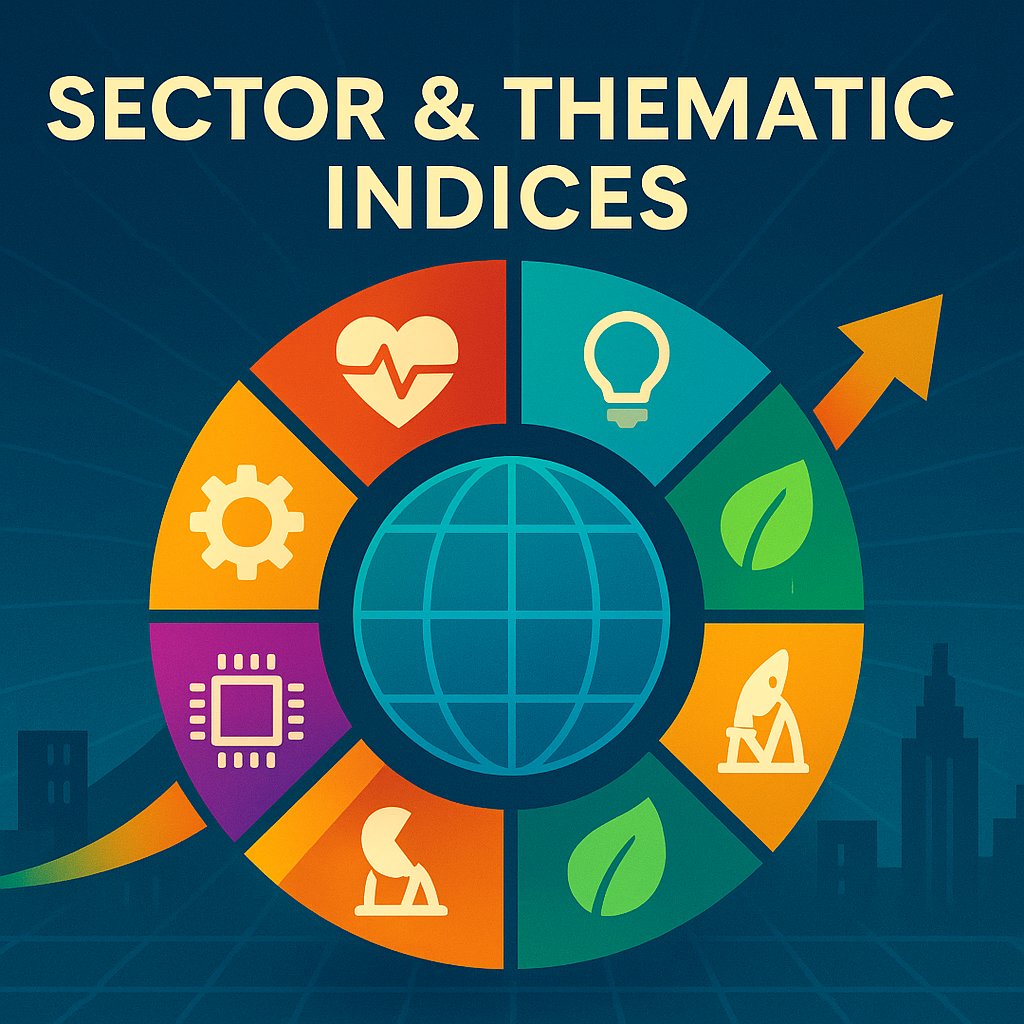Benchmarks that slice broad markets into industry‑specific or idea‑driven baskets—allowing investors to target exposure to, say, semiconductors, renewable energy, or cybersecurity rather than owning every stock in a parent index.

1. Two Flavors—Similar DNA
First, sector indices group companies by traditional industry classifications (e.g., GICS Technology or Health Care). Conversely, thematic indices leap across sectors to capture a unifying trend such as “Artificial Intelligence” or “Aging Population.” Despite that difference, both use transparent rules to select and weight constituents.
2. How They’re Constructed
| Step | Sector Index | Thematic Index |
|---|---|---|
| Universe | Parent benchmark (e.g., S&P 500) | Global or regional stock pool |
| Inclusion Rule | Single GICS code match | Revenue purity, patents, keyword screens |
| Weighting | Market‑cap or equal weight | Often modified equal or capped weight |
| Rebalance | Quarterly | Semi‑annual or quarterly |
| Governance | Parent index committee | Specialist or advisory panel |
Therefore, thematic baskets require deeper qualitative research, while sector lists rely on standardized classifications.
3. Representative Examples
| Index | Type | Highlight |
|---|---|---|
| S&P 500 Information Technology | Sector | 69 large‑cap U.S. tech names |
| MSCI World Health Care | Sector | 11 % weight in ACWI |
| NASDAQ Clean Edge Green Energy | Thematic | Renewable‑energy pure plays, equal weighted |
| Solactive Global Cybersecurity | Thematic | 40 stocks with ≥ 50 % cyber revenue |
| S&P Kensho Electric Vehicles | Thematic | AI‑driven keyword model finds EV leaders |
4. Investor Use‑Cases
Because they isolate narrow exposures, these indices:
- Express Conviction: For instance, overweight semiconductors without rewriting the entire portfolio.
- Diversify Within a Theme: Spreads risk across many stocks rather than a single “hot” name.
- Benchmark Active Managers: Sector funds compare against corresponding indices.
- Power ETFs & Derivatives: Passive products track index rules, enabling cost‑efficient access.
5. Strengths and Caveats
| Strengths | Caveats |
|---|---|
| Targeted beta captures secular trends | Concentration risk: top 10 holdings may exceed 60 % |
| Transparent, repeatable selection | Thematic screens can be subjective |
| Lower single‑stock risk than picking winners | Valuations may be rich if theme is crowded |
| Rebalance keeps focus fresh | Theme fatigue possible as narrative shifts |
6. Trends to Watch
Furthermore, index providers keep innovating:
- Multi‑Theme Hybrids: “AI + Robotics” or “Smart Mobility” baskets combine adjacent trends.
- ESG Overlays: Low‑carbon or SDG alignment layers added to classic sectors.
- Revenue‑Weighted Schemes: Shift weight toward pure‑play names rather than mega‑caps.
- Tokenised Delivery: On‑chain thematic indices aim to trade 24/7 with instant settlement.
Key Takeaways
Sector and thematic indices let investors tilt portfolios toward specific industries or megatrends without abandoning diversification. While sector baskets lean on standardized industry codes, thematic versions require qualitative judgments about future growth narratives. Either way, understanding the selection and weighting rules is vital before allocating capital.